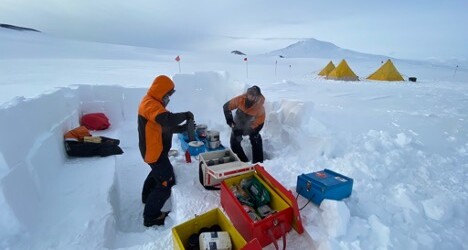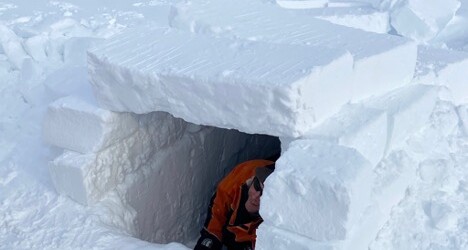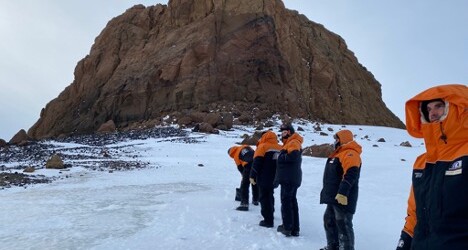To be able to do literally anything outside beyond the border of the base, each person has to complete Antarctic field training. As I was the only new comer in our group, I was the only one who had to complete the full 2-day course. The training started with a power point on team work and safety (like how to spot frost nip and prevent frost bite) and a notable a video of a large all-terrain amphibious vehicle called a Hägglund falling through an ice crack into the sea, looking like one of the worms from Dune had just swallowed it whole. It’s an image I will never unsee.
Next, we went over the contents of survival bags, learned how to start Primus stoves in cold temperatures with a flint, and how to make up sleep and kitchen kits. We gathered everything we would need for the evening, including fuel, pee bottles, a poop bucket and other supplies like shovels and snow saws. Then we got in a Hägglund (you can imagine our fear) and drove out across the sea ice to the field training camp situated in an area that was flagged as “safe”.
We learned how to set up Scott tents so that they wouldn’t blow away in the wind and how to secure them down with snow after digging the poles into the snow. Then we learned how to build an ice kitchen. Some of the crew decided to try their hand at building an emergency shelter, which involved cutting a coffin sized rectangle out of the snow, then cutting larger blocks of snow to put over the coffin. As the only woman of 8 people, I was quite happy when my tent mate decided to try his luck and sleep in it for the night. That made peeing into a bottle at night much easier in the comfort of my tent!
After getting the kitchen up and running, we melted snow on the stove and each had a meal of dehydrated food (beef curry for me). During the 10 minutes that it required to rehydrate we put the bags in our jackets to help keep us warm, and to keep the food from freezing. It wasn’t bad! But anything that returns your body temperature to a tolerable degree is going to be amazing! I was pretty surprised at how quickly I got cold when not moving. It was a delicate balance between doing work at a pace that wouldn’t make you sweat, but doing enough to stay warm. My hands got the coldest while shoveling snow, despite the gloves I wore, but pausing to warm them up from time to time kept them functional.
After dinner we got in the Hägglund again and went for what would be a “sun downer”, if the sun actually went down, up at Castle Rock. The view was gorgeous – Mt Erebus to the south, the expanse of McMurdo sound to the west, and Mt Terror to the east. We soaked in the view as long as possible before the windchill forced us back down the hill to our vehicle and back to camp.
We got lucky with a calm night and I managed to sleep pretty well in my double sleeping bag with a fleece liner atop a 4-inch fleece thermarest and sheepskin. We all survived the night – including my brave former tent-mate. After a chilly morning tea (so chilly that hot water flung into the air instantly froze into a puff of ice crystals), we packed up and headed out having all survived our first night camping in Antarctica.
When we returned, we went around and shared the “things that rocked” and the “things that would stick” with us – a general consensus was that the teamwork rocked (and was essential) and things that stuck involved making sure to warm up as soon as any coldness set in. Having a spare pair of socks for sleeping in was something that really stuck for me (my feet sweat and mine got wet!), but on reflection, and on a less practical note, what really stuck was the sound of the snow as people walked across it. It sounded like walking on Styrofoam. It’s unlike anything I’ve ever felt or heard before as I’ve never walked on snow in temperatures so cold that all the crystals remain frozen and very squeaky as they shift around under your weight.





